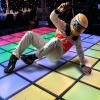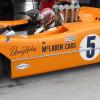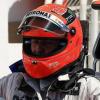
F1 driver fitness vs other sports
#1

Posted 12 October 2009 - 02:03
For instance during the Aussie V8 Supercar coverage of Bathurst over the weekend they had on-screen data showing heart-rates for the drivers, and they were in the 170-180bpm mark, which is pretty impressive for someone "just sitting there" for 6 hours.....
But how does that compare with athletes from other sports? Take soccer for instance....there's a degree of aerobic fitness required of course, but would it be more or less than an F1 driver? Any useful data to compare?
I'm not looking for an argument on "this sport is better than that sport", more about comparison of fitness metrics....training regimes, nutritional intakes, heart rates, aerobic capacities, weight loss, things of that nature. There are lots of "drivers lost 5kg a race" comments around, but anything concrete?
#3

Posted 12 October 2009 - 02:45
For motorsport, a lot of cardio is required, of course, and muscle endurance. Forearms, abs, back, necks, they all suffer quite a bit, actually, when your neck goes, u can hardly see the road you're driving on. For a person not used to racing, it would not take much longer than a handful of laps before your neck goes away if you just jump into a Formula 1 car out of the blue without the propper training, even if you're a professional athlete.
I used to train 3 hours a day just to stay in racing form. Lots of cardio, some weights, lots of abs, and a lot of neck training.
So, after you find your data, the next time your friends give you a hard time over Motorsport fitness, just ask them to go to the local track, rent a "racing" go kart (by racing I mean real racing, none of that 4 stroke, or rotax max, I mean, Intercontinental A, or Formula A, or Formula C). They won't last more than 5 laps before they have to stop for some air, trust me
Edited by Birelman, 12 October 2009 - 02:48.
#4

Posted 12 October 2009 - 02:53
#5

Posted 12 October 2009 - 03:07
Edited by MiPe, 12 October 2009 - 03:07.
#6

Posted 12 October 2009 - 03:13
Do you remember when Alonso fainted after the race in Bahrain? He was taken to the medical centre and Dr Riccardo Ceccarelli said that he was so dehydrated with such a low blood pressure that if he had been a "normal" person (not a driver), he would have been taken to hospital immediately.
#7

Posted 12 October 2009 - 05:21
http://www.f1complet.../view/2672/392/
http://www.formula1....sport/5298.html
http://www.stableroa...1fitness500.htm
Formula One Drivers Fitness E-mail
Aiming for the top in Formula One does not only mean spending time and effort on making a car go quicker. In the last few years, F1 teams have become more and more aware of the importance of keeping drivers in top physical and mental condition in order to enhance the global team performance.
Alike most of its competitors, Panasonic Toyota Racing has totally integrated this aspect as a priority and puts a premium on making sure its drivers are given the best possible training and medical care:
- Panasonic Toyota Racing is the first Formula One team with full-time medical doctor
- Dr Riccardo Ceccarelli is one of F1's leading medical practitioners with a record in the sport stretching back more than 10 years
- For the first time in the sports, both a doctor and a physio attend every test session and every race weekend.
A round-the-clock programme for body and mind
A driver's fitness programme is based on the definition of a profile that combines the human factor with the athletic abilities. Everyone responds differently to the various trainings and therapy methods and it is important to find the best possible formula.
- Drivers undergo an initial complete checks including food intolerance test and personality questionnaire
- A personalised fitness programme is then established combining indoor and outdoor activities
- These activities are backed with a personalised diet
- Drivers are also introduced to relaxation and concentration techniques
All these elements are planned to form a round-the clock programme for body and mind, adjusted to the drivers' schedule: it has to fit in between racing, testing and fulfilling PR duties, which has become so important nowadays. Over winter it is easier to carry out fitness development programmes over several days or weeks while during the racing season, work is focused on maintaining the level of fitness through short training sessions.
As for Panasonic Toyota Racing, the huge task of planning and following-up drivers fitness is left to the highly experienced Dr Ceccarelli:
"I give the drivers a full training", says the doctor, "starting with a full medical check-up and physical analysis conducted in the gym by collecting various data. From these information I can draw conclusions on the driver's body fluid level, stress level, muscular mass but also on his physical and mental energy: some drivers are like engines they consume a lot of "fuel" during a race, others less. Then I design the appropriate fitness programme - including nutrition - to help the driver to use all of his potential for an entire race."
Tremendous constraints
Drivers' fitness is tailored-made to offer the best possible answers to these facts:
- The Lateral G-forces exerted on a driver can be as much as 4.5 G, which means about 25 kg on the neck
- The Longitudinal G-forces exerted on a driver can be as much as 4.5
- Acceleration: to 1G, braking up to 4.5G, cornering up to 3G
- For instance, a F1 car can brake from 185kph to stand still in 3.5seconds and 80 metres (rate of deceleration 4G)
- The heart rate can reach 170 - 190 BPM for example on the starting grid
- During a Grand Prix, the pulse rate of a Formula 1 driver hovers around 160 beats per minute, and has peaks of over 200. The pulse rate of a healthy young man is typically in the region of 60 beats per minute.
- Blood pressure can increase up to 50% whilst racing
Training
Improving a F1 driver's muscular mass and endurance implies a very localised bodybuilding: any car designer will indeed tell you that the thinner, the lighter, the better to fit in the tiny F1 car cockpit. It is then important to develop strength without increasing volume and weight too much. Some specific muscles groups particularly need to be developed, one of the most important being without doubt the driver's neck.
Some activities are commonly integrated to all drivers fitness programme:
- indoor activities: running and cycling on machines, weight-lifting as well as training on special equipment designed to reproduce F1 racing conditions.
- outdoor activities: mountain biking, race cycling, jogging, tennis, kayak (which is excellent for cardio-vascular training)
Most of the time, the programme has to be completed with the drivers' favourite activities. As they have to train so long hours, it is important that they do not get bored too quickly...
Drinking and eating
Peak physical condition and response to F1 cars constraints is also given by a proper healthy diet. The point is to provide energy, proteins (main muscles feeder) and minerals without slowing down metabolism and digestive system, as this does not only affect the body but also the mind capacities and reactions.
- F1 Drivers loose approx. 2-3 litres of water during a race
- Importance of fluid level in the body has been underlined by sports studies showing that a person losing just 4% of their body weight can lose up to 40% of their psycho-physical capacity.
- The average recommended daily fluid intake is four litres (which few common people manage)
- The Toyota drivers drink no less than 8 litres in the days preceding very hot races like Australia, Malaysia, and Brazil...
- Drivers have a drinking bottle (containing water and mineral salts) installed in the cockpit with a pipe going through their helmet. Capacity around 75cl.
A typical regime is a balanced diet of carbohydrates, protein and various vitamins and minerals, if necessary through a complement aside of meals.
No wonder why all drivers regularly quote mineral water and pasta as their favourite food and drink...
A typical race day menu
The time when meals are taken also has an impact on performance and nothing is left to chance, particularly on a race day:
07:30 Breakfast: milk and/or yoghurt, cereals, fresh fruits...
08:00 Massage to wake up and warm-up muscles
09:30 Warm-up session
Throughout the day, drivers drink carbohydrated drinks, which are an excellent way to hydrate the body and provide him with energy without hampering digestion
10:00/11:30 Warm-up technical debrief followed by PR activities
Ideally lunch should take place about 4 hours prior to the start of the race but it is generally very difficult to fit this in the race day schedule. Therefore drivers usually do as follow:
11:30 Very light portion of pasta, vegetable soup
12:00 Drivers take a rest and most of the time sleep
12:40 30-minute massage to reawaken muscles
13:15 Drivers get ready to jump in their race car
14:00 Race start
End of the race Debriefing and PR duties followed after a certain time by relaxing massage and a good meal to recover lost proteins and vitamins.
Concentrating
The sensitivity of a top-line Formula 1 driver is so finely developed that he can feel a change as tiny as 0.5% in front-rear aerodynamic balance. He can sense a difference in the car's behaviour if its front ride height is altered by as little as 1mm.
Throughout the race, a driver aims to keep his engine RPM within a band of 2000rpm (where maximum power is produced). He can judge his pace so exactly that, on a clear track, he can repeatedly achieve consecutive lap-times within a range of 0.2 second.
It is then utterly important to help him maintaining a perfect level of concentration throughout the race to keep all his senses at their peak awareness. To that effect, a special training based on in depth medical and psychophysical studies is given to the drivers to enable them to control stress level and work on their concentration.
A team priority
Panasonic Toyota Racing, since starting from a clean sheet of paper just about three years ago, has always put a premium on motivating its staff and helping him to perform well.
The team is made up of over 550 people, 30 nationalities, of which 70 people travel to the races and about 50 to the tests: mental and physical fitness programs are proposed for the team as a whole, taking into account the needs and specificities of each group, including sedentary staff at the Toyota F1 Factory in Cologne.
A fully equipped gym has been opened with fitness trainers available to establish personalised programmes for team personnel. With people having to work so many hours providing such facilities make their life easier.
The team drivers are constantly accompanied and followed-up in their mental and physical preparation.
A professional program for young drivers is also conducted.
The future
By entering into co-operation with Dr Ceccarelli, the Panasonic Toyota Racing team has become a sort of full-size laboratory for medical research on the drivers and F1 team members. Looking after drivers training programme has now fully become a science as developed as the one applied to enhance the car's performance. Dr Ceccarelli collaborate on pioneering research like:
- Development of a telemetric system to monitor drivers during the races
- Electrocardiogram and heart rate / Body temperature / Blood pressure
- Measurement of the neck muscles work by accelerometers and inclinometers
- Breathing rate and volumes
- Improved understanding of the psychophysical demands on drivers
- Application of research learnt on track to the everyday driver for safety & enjoyment
- Promotion of the importance of healthy driving to the general public
#8

Posted 12 October 2009 - 07:26
That's intresting, but I cannot helped to think it's Toyota all right for you. They are really comprehensive on one side, on the other hand one wonders if they are trying too much of a control, and next to the car, they are also trying to take control of driver's life; but, it's short lived, and I can't see any harm incurring on the long run.Sorry for all the cutty pastey but I was intrigued, and this is what I found.
http://www.f1complet.../view/2672/392/
http://www.formula1....sport/5298.html
http://www.stableroa...1fitness500.htm
Edited by MiPe, 12 October 2009 - 07:27.
#9

Posted 12 October 2009 - 07:31
My track days on my bike were maybe 7 laps before I had to pit. Serious goddamn work. Half the Gs and half the acceleration and half the speed. Imagine doing that for two hours. Or for 5 hours a day during testing. Road car track time seems like taking grandma to the shops compared to it.
Not a sport? My ass.
#10

Posted 12 October 2009 - 10:25
#11

Posted 12 October 2009 - 11:09
- during 17-minute go-kart race I had an average heart rate of 162 (including 2 warm-up and 1 cool-down laps)
- during three-hour mountain bike marathon the average rate was 164 (from start to finish)
- during cross-county skiing (35-minute training involving steep slopes and extremely bad slide) I had average of 164
- my absolute highest average was 168 during 20 minutes of biking at full pace
Go-kart is of course not F1. G-forces are much lower but you have to work all the time. Track I recorded my rate has the longest straight of less than 100 m.
#12

Posted 12 October 2009 - 11:29
One thing I constantly hear from my non-motorsport watching friends is that "it's not a sport cause all they do is sit there and push the pedal and turn the wheel". Whilst that's a very simplistic view, and I of course try and point out just how fit they are, it would be nice to have some more specific data.....does anyone have any articles/info/links etc to just how fit these guys are?
For instance during the Aussie V8 Supercar coverage of Bathurst over the weekend they had on-screen data showing heart-rates for the drivers, and they were in the 170-180bpm mark, which is pretty impressive for someone "just sitting there" for 6 hours.....
But how does that compare with athletes from other sports? Take soccer for instance....there's a degree of aerobic fitness required of course, but would it be more or less than an F1 driver? Any useful data to compare?
I'm not looking for an argument on "this sport is better than that sport", more about comparison of fitness metrics....training regimes, nutritional intakes, heart rates, aerobic capacities, weight loss, things of that nature. There are lots of "drivers lost 5kg a race" comments around, but anything concrete?
Trulli and Kovalainen have participated in marathons lately and IIRC had times around 3 hours 15-30 min mark which is very good but nothing stellar, as almost any normal young(ish) person could achieve that kind of times through vigorous specialized training. To put it short, the driver's main function is to brake, accelerate, steer and correct at precise moments and need physical health only sufficient to keep that up at certain level over one GP and recover quick enough for the next one.
So the main emphasis is skill and the physical attributes are secondary, just as long as the physical attributes are good enough. It's more or less the same with lots of more redeemed "sports", like most ballgames and such. Driving a F1, or playing tennis or as you said soccer, are actually closely related, and none of the brightest stars of such sports would be a match for a specialized athlete competing in specific "real sport" just measuring all-out performance in some specific physical attribute. It's also useless to compare single physical attributes between sports as the skill sports have emphasis on different physical areas, but the overall physical training effort is probably pretty similar in F1, soccer, tennis, basketball etc.
You could tell your friends that F1 is a skill sport, but still physically demanding and at top level requiring hard driving specific training and hence being even physically something that your friends (at their present shape) wouldn't be able to do. If they still persist, tell them to go drive in F1 and while at it make the top eight in Wimbledon as well and then buy you a brand new car or two with the prize money.
#13

Posted 12 October 2009 - 11:53
I'm too young to remember it, but didn't racing drivers nearly always win on Superstars?
On the BBC version, I don't remember how many racing drivers took part (I'm sure it was more than the BBC's result list shows, but I don't remember the exact format of the series- was it weekly elimination rounds then a final?), but Jackie Stewart and James Hunt both did well- both finished in the top 3
http://news.bbc.co.u...ars/2959150.stm
Edited by Kevan, 12 October 2009 - 11:55.
#14

Posted 12 October 2009 - 13:01
#15

Posted 12 October 2009 - 13:21
Trulli and Kovalainen have participated in marathons lately and IIRC had times around 3 hours 15-30 min mark which is very good but nothing stellar, as almost any normal young(ish) person could achieve that kind of times through vigorous specialized training. To put it short, the driver's main function is to brake, accelerate, steer and correct at precise moments and need physical health only sufficient to keep that up at certain level over one GP and recover quick enough for the next one.
So the main emphasis is skill and the physical attributes are secondary, just as long as the physical attributes are good enough. It's more or less the same with lots of more redeemed "sports", like most ballgames and such. Driving a F1, or playing tennis or as you said soccer, are actually closely related, and none of the brightest stars of such sports would be a match for a specialized athlete competing in specific "real sport" just measuring all-out performance in some specific physical attribute. It's also useless to compare single physical attributes between sports as the skill sports have emphasis on different physical areas, but the overall physical training effort is probably pretty similar in F1, soccer, tennis, basketball etc.
You could tell your friends that F1 is a skill sport, but still physically demanding and at top level requiring hard driving specific training and hence being even physically something that your friends (at their present shape) wouldn't be able to do. If they still persist, tell them to go drive in F1 and while at it make the top eight in Wimbledon as well and then buy you a brand new car or two with the prize money.
That's not really true. There is a direct connection between pace and physical condition/stamina.
No super athlete would be able to do anything in an F1 car.
Driver skill was for most part, historically, superior driver physical condition/stamina due to genetics and/or preparation.
Fangio beat a lot of his opponents because simply he outlasted them; as they grew more and more tired their pace dropped and they were more prone to mistakes.
#16

Posted 12 October 2009 - 14:24
That's not really true. There is a direct connection between pace and physical condition/stamina.
No super athlete would be able to do anything in an F1 car.
Driver skill was for most part, historically, superior driver physical condition/stamina due to genetics and/or preparation.
Fangio beat a lot of his opponents because simply he outlasted them; as they grew more and more tired their pace dropped and they were more prone to mistakes.
What was not true because that was pretty much just what I said?
#17

Posted 12 October 2009 - 20:30
Since we are talking F1 I have no doubt this sport is extreme in it's physical (not to mention mental) demands. Don't listen to the knuckle draggers in the sports rooms of media companies who say motorsports aren't real sports. We get it from these oval ball nuts all the time in New Zealand.
#18

Posted 12 October 2009 - 20:39
We get it from these oval ball nuts all the time in New Zealand.
Thier idea of post match fitness is going out and getting obliterated and beating on the locals, eating fast food and getting caught in dodgy sex rampages.
Edited by klyster, 12 October 2009 - 20:41.
#19

Posted 12 October 2009 - 20:47
Advertisement
#20

Posted 12 October 2009 - 20:51
#21

Posted 12 October 2009 - 20:56
http://www.acsm.org/...;CONTENTID=4285
http://nbcsports.msnbc.com/id/4243400/
http://www.cnn.com/2...SCAR/index.html
#22

Posted 12 October 2009 - 21:01
Nah, Brian Jacks kicked everyones ass.I'm too young to remember it, but didn't racing drivers nearly always win on Superstars?
#23

Posted 12 October 2009 - 21:06
Whats happening in the last 20 years or so is that drivers try to be as lightweight as possible so they have an advantage in moving ballast in the car. Compared to other athletes Formula 1 drivers look like kids.
Which is why taller drivers struggle. They also need to be supremely fit but in a streamlined fashion.
A lot of drivers seem to play football. Schumacher was semi-pro (ok with a lower division Swiss team). I would say it might be because of stamina but F1 drivers dont get a rest, whereas a footballer can catch his breath and do have a half time break.
How many sports are non-stop physical punishment for up to 2 hours mentally and physically without a break? I can only think of cycling. However that is concentrated on different muscles.
I am talking waffle here as I do virtually no exercise. I ensure I get 25 miles of walking per week and thats it. What do I know? I couldn't do it.
#24

Posted 12 October 2009 - 21:08
marathon drivers are not very big also...can't say they are not fit,can we?Whats happening in the last 20 years or so is that drivers try to be as lightweight as possible so they have an advantage in moving ballast in the car. Compared to other athletes Formula 1 drivers look like kids.
#25

Posted 12 October 2009 - 21:08
Whats happening in the last 20 years or so is that drivers try to be as lightweight as possible so they have an advantage in moving ballast in the car. Compared to other athletes Formula 1 drivers look like kids.
alonso mentioned he did more than 3000kms biking during winter testing, and I don't mean separatedly from the testing, I mean he got on the bike as soon as the flag dropped down
webber had this accidente in tazmania biking...button doing triathlon, trully and kova running the marathon...
crazy stuff!!!!
#27

Posted 14 October 2009 - 08:12
#28

Posted 14 October 2009 - 08:26
Which is why taller drivers struggle. They also need to be supremely fit but in a streamlined fashion.
A lot of drivers seem to play football. Schumacher was semi-pro (ok with a lower division Swiss team). I would say it might be because of stamina but F1 drivers dont get a rest, whereas a footballer can catch his breath and do have a half time break.
How many sports are non-stop physical punishment for up to 2 hours mentally and physically without a break? I can only think of cycling. However that is concentrated on different muscles.
F1 drivers do get a rest on straights, the pressing G-Forces in the corners and under heavy braking is what is hard
Edited by Kucki, 14 October 2009 - 08:27.
#30

Posted 14 October 2009 - 10:49
Nah, Brian Jacks kicked everyones ass.
+1
The water skier, Hazlewood and Pole Vaulter, Hooper?? were also pretty useful.
Anyone remember when keegan fell off his bike, they were all so competive in those days.
Can you imagine the teams/managers letting people like Rooney/Gerrard or Hamilton compete now, It'll never happen
#31

Posted 14 October 2009 - 10:59
Check out Ron Pickerings Trousers
#32

Posted 14 October 2009 - 12:17
You can probably find accurate data for this with some research.
For motorsport, a lot of cardio is required, of course, and muscle endurance. Forearms, abs, back, necks, they all suffer quite a bit, actually, when your neck goes, u can hardly see the road you're driving on. For a person not used to racing, it would not take much longer than a handful of laps before your neck goes away if you just jump into a Formula 1 car out of the blue without the propper training, even if you're a professional athlete.
I used to train 3 hours a day just to stay in racing form. Lots of cardio, some weights, lots of abs, and a lot of neck training.
So, after you find your data, the next time your friends give you a hard time over Motorsport fitness, just ask them to go to the local track, rent a "racing" go kart (by racing I mean real racing, none of that 4 stroke, or rotax max, I mean, Intercontinental A, or Formula A, or Formula C). They won't last more than 5 laps before they have to stop for some air, trust me
The 4 Stroke will do the job. May be not in 5 laps, but after 30' I nearly fainted.




























